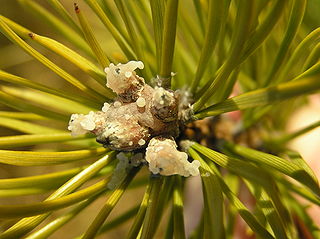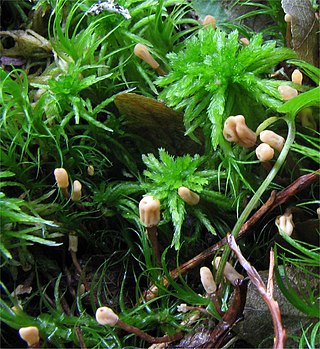
Gremmeniella is a genus of fungi in the family Helotiaceae. The genus contains at least 3 species.

Joseph Alexandre Laboulbène was a French physician and entomologist. A friend of the entomologist Jean-Marie Léon Dufour (1780-1865), he studied medicine in the University of Paris and was awarded the title Docteur in 1854. He taught in the medical faculty until 1879. Laboulbène was interested in harmful insects notably in the Order Diptera. The order of mushrooms Laboulbeniales, is dedicated to him, by Engler in 1898.
Durandiella is a genus of fungi in the family Dermateaceae. The genus contains 10 species.
Dennisiodiscus is a genus of fungi in the family Dermateaceae. The genus contains 10 species.
Pirottaea is a genus of fungi in the family Dermateaceae. The genus contained 26 species in 2009. It went up to about 48 species later.
Sorokina is a genus of fungi in the family Dermateaceae. The genus contains 6 species.

Sawadaea is a genus of fungi in the family Erysiphaceae. The widespread genus contains nine species. One more species was added in 2011.
Godroniopsis is a genus of fungi in the family Helotiaceae. The genus contains two species.
Godronia is a genus of fungi in the family Helotiaceae. The genus contains 27 species.
Grovesiella is a genus of fungi in the family Helotiaceae. The genus contains three species.
Pestalopezia is a genus of fungi in the family Helotiaceae. The genus contains three species.

Heyderia is a genus of fungi in the family Hemiphacidiaceae. The genus contains six species.
Montagnula is a genus of fungi in the family Montagnulaceae. The genus, circumscribed by mycologist Augusto Napoleone Berlese in 1896, contains an estimated 24 species, but is probably polyphyletic as currently circumscribed.
Kalmusia is a genus of fungi in the family Montagnulaceae. The genus is estimated to contain about 12 widespread species.
Zopfia is a genus of fungi in the family Zopfiaceae. The widespread genus contained 5 species, until another species was accepted.
Roumegueriella is a genus of fungi in the class Sordariomycetes. It consists of three species.
Marcelleina is a genus of fungi within the Pezizaceae family. The genus was circumscribed in 1967.
Jenmania is a genus of fungi within the family Lichinaceae. The genus contains two species.
The Vialaeaceae are a family of fungi in the Ascomycota and class Sordariomycetes. In 2018, it was placed in the order Amphisphaeriales.
Valetoniella is a genus of fungi within the Niessliaceae family. The genus contains three species.




